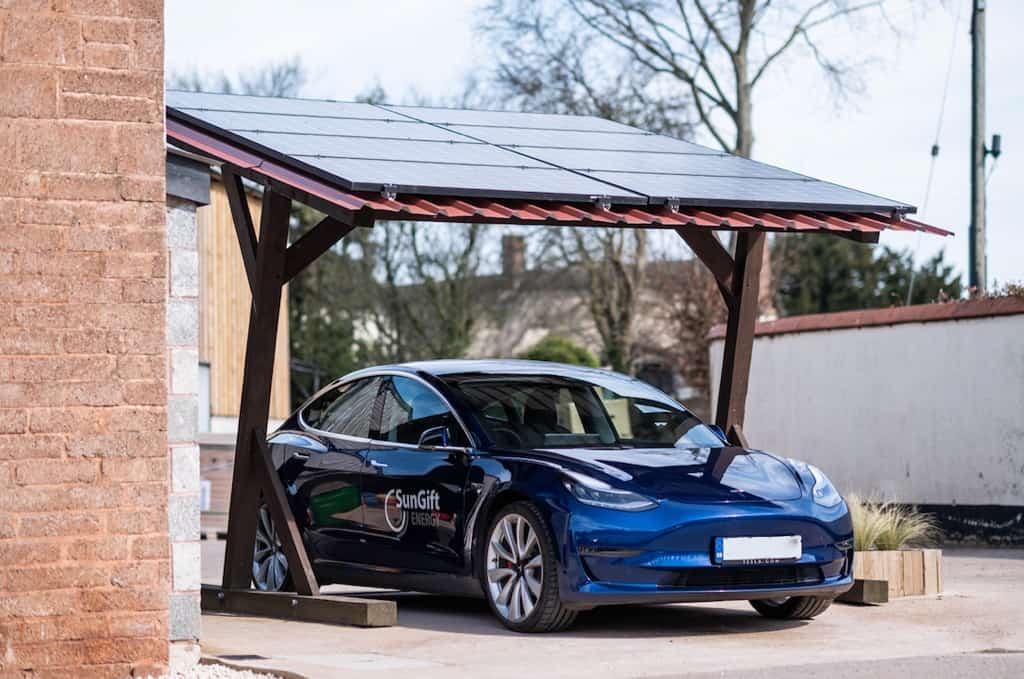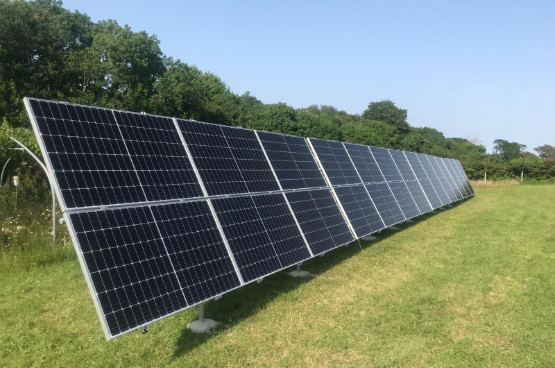How can I charge my EV from my solar PV system?
Your EV charging point is so much more than just a fancy plug socket for your car.
An EV charge point with solar PV integration will monitor your house’s energy consumption and compare it to your solar PV generation. When there is a surplus of energy from the solar PV, rather than exporting this energy back to the grid, it will use it to charge up the EV battery.
The easiest way to explain this is with an example.
Let’s say your PV system is generating 3kW, but your house is only using 1kW. The remaining 2kW has to go somewhere. Without a solar EV charger, this energy will get sold back to the grid for a maximum of 5.5p/kWh under the Smart Export Guarantee (SEG). However, with a solar EV charger, the remaining 2kW will be diverted into your EV battery. The charger will continually monitor your surplus solar PV generation and adjust the EV charging rate accordingly.
In this example, let’s say it’s a sunny, clear day and your PV system generates 20kWh in total. Your house only used 5kWh during this time. If the EV was plugged in all day, the EV charger will have diverted the surplus 15kWh of energy into the EV battery. That’s about 67 miles of range in Ollie’s Tesla, the equivalent of a round trip from Exeter to Taunton.
Now that we know how solar EV charging works, I’ll walk you through one of our favourites chargers, the Zappi.
What is a Zappi?
The Zappi is a smart EV charger made in Britain by a company called MyEnergi. When it comes to solar EV charging, the Zappi is in pole position.
There are three different charging modes to try out.
- Fast
- Eco+
- Eco
Fast Mode
Just got back from the shops and need to head out again in an hour? Car battery nearly empty? This is when Fast mode is great. In this mode, the Zappi will simply charge your EV as fast as possible (usually 7kW). The Zappi will take the full 7kW regardless of how much your solar PV is generating. This means that you will need to import some energy from the grid when using this mode.
Eco+
Not going to use your EV today? This is where the Zappi comes into its element. In Eco+ mode, the Zappi will only charge from any surplus PV energy you are generating. This is perfect if you plan on leaving the EV plugged in for several hours during the day. The surplus solar energy will be trickle fed into the EV battery. With no energy coming from the grid, this is the greenest way to charge your EV.
Most EVs have a minimum charging rate of 1.4kW. If your surplus solar generation falls below 1.4kW, then the EV will stop charging. For example, if your house is demanding 1kW, your solar PV system will need to be generating 2.4kW or more for the Zappi to start charging the EV in Eco+ mode.
Eco
Eco mode is very similar to Eco+ mode, but with one key difference. If the surplus solar PV generation falls below 1.4kW, the Zappi will draw the extra energy required from the grid, to ensure that EV is always charging at a minimum of 1.4kW. For example, your house is demanding 1kW and your solar PV system is generating 2kW. There is a surplus of 1kW from the solar, which is not enough to start the EV charging (minimum 1.4kW). In Eco mode, the Zappi will draw the remaining 0.4kW from the grid in order to start the charging process.
With the extra Hub device (also made by MyEnergi), you can control and monitor all of the Zappi features and modes. Ollie even made a short video explaining how he uses his own Zappi at his house.

Another shot of Ollie’s Tesla, this time being charged up by our solar carport.
Other EV charge point manufacturers have similar solar smart chargers, but none offer the full package like the Zappi. Alternative options include the EO Smart Home EV Charger. With this model you can charge in the equivalent of Fast and Eco mode, but not Eco+. SolarEdge also makes a solar EV charger, but only has the equivalent of Fast and Eco+ mode (you also need a SolarEdge PV system, whereas the Zappi is compatible with any PV system).
Is solar EV charging for me?
This might all sound fantastic, but will it suit your needs?
The first thing you might want to consider is – when will you typically charge your EV? The more time your EV spends parked on the driveway during the day, the more you will benefit from solar charging. But what if I drive my EV to work 5 days a week? Firstly, you’ll still be able to benefit from solar charging at the weekends and holidays. Secondly, you might be able to benefit from a small amount of solar EV charging in the evenings.
In the UK summertime, the sun can set as late as 9:21pm, so even after work, there are a few hours in which to benefit from solar charging. It may not seem like much, but over the course of the summer this could add up to some significant mileage. Let’s say that between May-August you charge your EV for 1 hour each evening at the minimum threshold of 1.4kW. That’s 1.4kWh per day for 123 days, totalling 172kWh. This is the equivalent of about 860 miles of summer driving in Ollie’s Tesla – nothing to shy away from!
Secondly, how big is your PV system? If your PV system size is only 2kW, then it will be a rarity that the PV will generate enough surplus to get above the 1.4kW starting threshold. A better way to increase your solar self-consumption might be through battery storage or immersion diversion.
Finally, what sort of demand will be coming from your house? If you use a lot of energy during the day or plan to store surplus solar energy in a home battery or by heating water, then you might not have much of a surplus leftover to be diverted into the EV. However, the Zappi is fully compatible with battery storage, allowing you to prioritise where your surplus solar energy goes.
So in Conclusion…
Solar EV charging is a great way to ensure that your EV is constantly topped up with clean energy from your solar PV system. The key benefits are:
- Energy from your solar PV is free, so it will make driving much cheaper
- Increase your solar self-consumption. The surplus energy would have otherwise been sold back to the grid for a maximum of 5.5p/kWh. With a solar EV charger, each kWh that goes into your EV saves you 15p – another financial incentive
- Environmentally, charging your EV from your solar PV is emissions-free. The UK grid electricity mix is made up of predominantly fossil fuels (mainly gas), renewable (mainly wind and solar) and nuclear power, so charging an EV from the grid isn’t technically an emissions-free process. You can monitor the UK electricity grid mix here, http://grid.iamkate.com/. At the time of writing, renewables are providing 41.6% of national electricity demand!
Let us know if you are interested in charging your EV from solar power and we will do our best to get you driving on sunshine!
Feel free to Contact us.

 Solar PV Contractor of the Year 2024
Solar PV Contractor of the Year 2024
